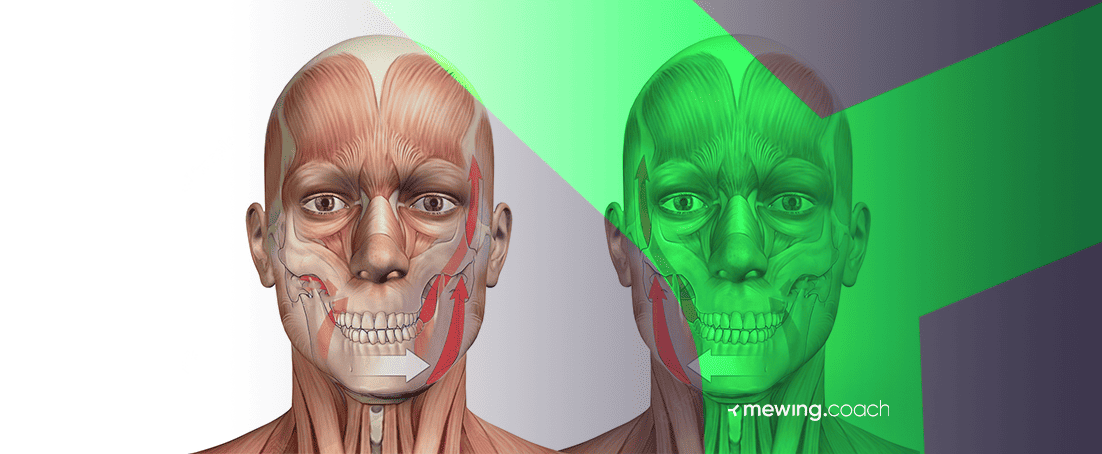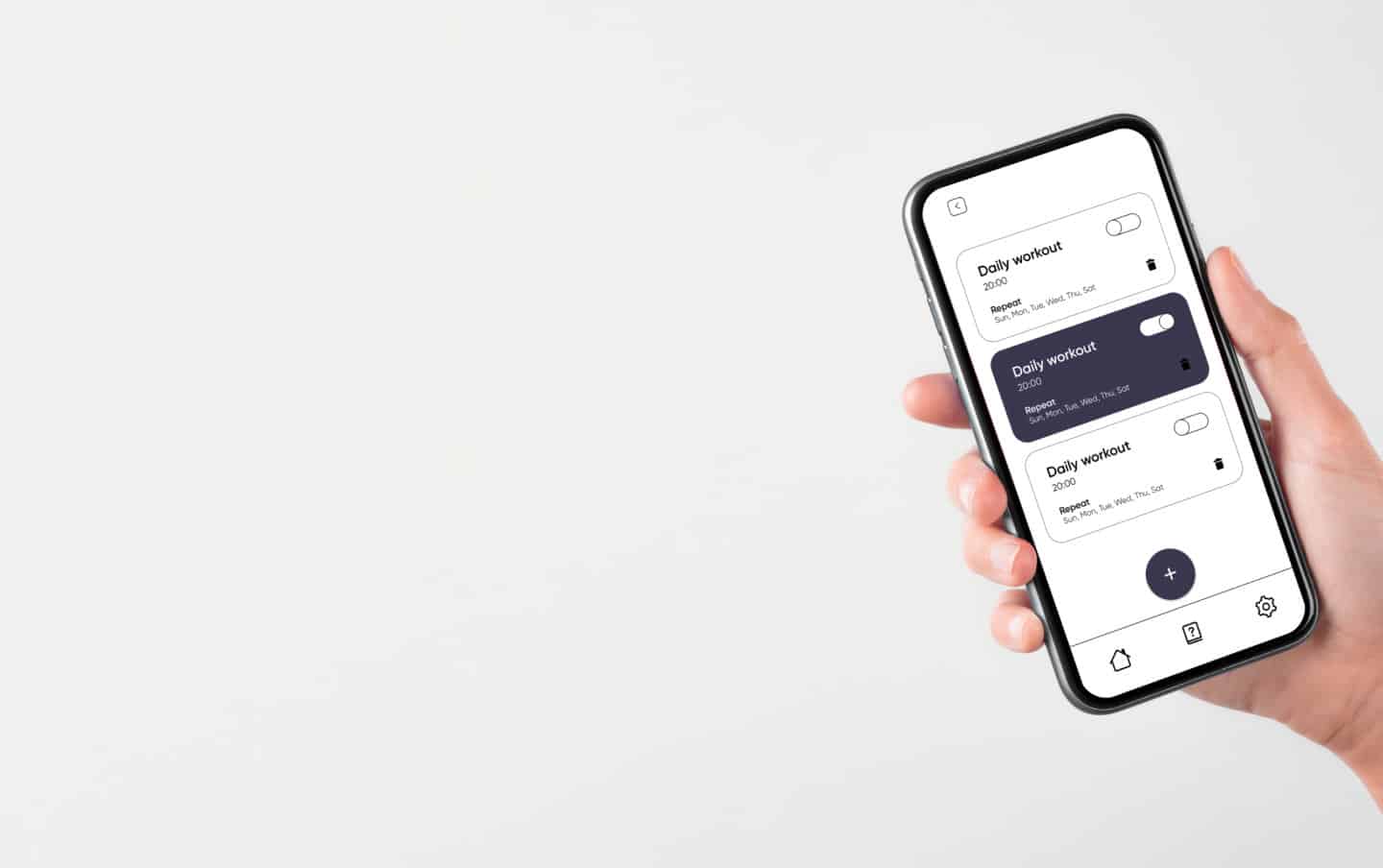Lateral jaw deviation is a more or less visible asymmetry of the face and jaw muscles, especially when viewed from the front. It is caused by the uneven alignment of the lateral pterygoid muscles and masseter muscles connected to the temporomandibular joint.
Scientifically, it is also referred to as functional lateral deviation because it can cause facial asymmetry but also muscle spasm and jaw pain, irregular biting and jaw movement, and, in the worst cases, facial pain.
In this article, we’ll look through:
-
👄 The function of the temporomandibular joint in the face and head motion
-
💆♀️ Some methods and manual therapy to treat the temporomandibular disorder
- ✔ How to relax jaw muscles and get rid of TMJ pain the natural way
We’ll also remind you of the mewing effects on the jaw, so keep on reading.

What Muscle Controls the Lateral Deviation of the Mandible?
Our jawline is connected to the head through the Temporomandibular Joint (TMJ) or jaw joint, which is a synovial joint with a vast range of motion and rotation options. It’s located between the mandibular condyle and the mandibular fossa of our temporal bone.
The muscles that control it are the lateral pterygoid muscles, which are the main active group of muscles during mandibular movements and mastication, such as:
- Protrusion – the forward movement of the mandibula
- Abduction – the depression of the mandible
- Mediotrusion – the mandibular condyle middle movement.
While the lateral pterygoid muscle performs the mediolateral mandibular movement of the medial pterygoid, the temporalis muscle continuously shapes a wide range of anteroposterior (back and forth) movements of the jawline.
Symptoms of Lateral Jaw Deviation
While TMJ is the main joint moving the jawline, our entire scheme of movements is enabled thanks to numerous muscles and ligaments holding the upper neck, jawline and head together. Some symptoms of lateral mandibular deviation include TMJ pain and some of the following:
- Pain or discomfort in the jaw, face, or neck
Feeling pain and discomfort in the face area can be a sign of lateral jaw deviation. However, it can’t be taken as an isolated symptom, as it could mean many different things, such as tooth pain.
- Difficulty biting or chewing food
Lateral jaw deviation can make it difficult to open your mouth more than usual. It can also make it difficult to chew, particularly on one side.
- Difficulty speaking or making certain sounds
Each vowel and letter require a different mouth positioning. Lateral jaw deviation can make it difficult to whistle or pronounce specific letters.
- Chronic headaches or migraines
The extra pressure applied by the TMJ can inflict painful migraines. But this, once again, can’t be treated as an isolated symptom because migraines can be caused by many other reasons.
- Tension or pain in the neck and shoulders
If you feel tension and pain in the upper neck area, specifically in the shoulder and the chest bone, it could be because some muscles are tenser and stretched more than usual.
- Visible misalignment of the jaw or teeth
Visibly misaligned teeth and jaw, as well as crippled teeth followed by jaw pain, are undisputed symptoms of lateral jaw deviation.
What Causes Lateral Jaw Shifting?
Despite our jawline genetics, some features, such as chewing irregularly, broken teeth, or doing sports like boxing, can create mandibular asymmetries. Here are some crucial functional factors that cause a lateral functional shift:
Developmental Issues
During our growth period, our body goes through a lot of changes on both physical and mental levels. Stress, anxiety and depression can cause people to bite their nails or clench their teeth while awake or while sleeping. This can cause certain asymmetry of the upper teeth and cause the lateral jaw muscles to shift to one side more than the other.
Sometimes, applying irregular force while doing exercises to improve the jawline can have the opposite effect. And sometimes, even a dental procedure, oral surgery, or wearing teeth appliances can further cause the development of a shifted side due to pain and discomfort in specific areas.
Trauma or Injury to the Jaw
Compression force can have a large impact on facial symmetry. A broken or misaligned jaw can be caused by a strong punch (like when boxing) or a car accident, a bike crash, or even a skiing incident.
The TMJ can easily be dislocated due to its shape and structure. Sometimes, a crack would need surgical assistance, which involves a long recovery process. However, in most cases, the recovery is made simply by waiting, and thus, a certain shift or lateral jaw deviation occurs.
Certain Medical Conditions
In some instances, medical conditions like TMJ disorder and rheumatoid arthritis can have that effect:
temporomandibular joint disorder (tmj)
Since lateral jaw deviation is a type of TMJ disorder, it can easily be caused by another factor, such as teeth clenching or a dislocated joint. As a complex system of movements enabled thanks to the sliding ability of the TMJ, pain and numerous other misalignments and shifts in the correct movement can cause TMJ disorders.
Rheumatoid Arthritis
This is a specific condition of weak joints caused by an autoimmune and inflammatory disease. Unlike arthritis, which is typical for the elderly, when someone has rheumatoid arthritis, their immune system attacks the healthy joint and muscle cells by mistake, causing swelling and pain in the area.
Since this disease attacks multiple joints at once, it takes more than TMJ pain to establish a rheumatoid arthritis diagnosis.
Malocclusion (Misalignment of the Teeth)
Teeth misalignments can be caused by various reasons, such as having extra or fewer teeth than usual. Thumb sucking or the extended use of pacifiers and baby bottles can also contribute to malocclusion.
Basically, there are three types of malocclusions:
- Class I is where the upper teeth overlap the lower teeth. This is the regular position of our teeth, but in this case, the ratio is a bit bigger than usual;
- Class II malocclusion is known as overbite or retrognathism, and it’s the condition where the upper jaw seriously and visibly overlaps the lower;
- Class III is called prognathism or underbite – when the lower jaw sticks out, causing the teeth to overlap the upper teeth.
Teeth Grinding or Clenching (Bruxism)
Teeth grinding, clenching, or gnashing is medically known as bruxism. It can occur while awake or, at night, while sleeping.
While sleep bruxism is considered a sleep-related disorder, awake bruxism is commonly connected to the person’s temperament and anxiety level. Also, because bruxism is common in children, early treatment can prevent further mandible dysfunction.
Treatment Options for Lateral Jaw Deviation
There are specific treatments and physical exercises that can be used to help align the lateral jaw muscles, and there are also surgical procedures for vast and visible deviations:
Non-surgical options
Whatever the cause for your deviation may be, trying out a natural way isn’t only good for your budget, but it’s a less painful and less risky option.
Mewing
If you’re not aware of this facial yoga concept, make sure to check out this article as a resourceful mewing description. Or, simply download and install our free Mewing.coach app and dive into the numerous gadgets and personalized features that can adapt to your every need!
So, if you’re looking for solutions for strengthening a weak jaw or want to correct your misaligned jaw muscles, these exercises will help. Plus, your progress is never lost within the app, and the fact that each exercise is accompanied by a video tutorial promises better chances of mastering the technique.
Physical therapy to strengthen and help relax jaw muscles
Physical therapy is the most common approach for positional recovery of the mandible shift. It’s a manual therapy performed by a professional physical therapist because it has to activate the muscle knot inside the muscle tissue.
A commonly used technique for relaxing the jaw muscles is TPR (trigger, point, release). Activating the masseter muscles, the medial and lateral pterygoid muscles and the temporalis muscle can decrease TMJ pain and also fix the wrong posture of the jaw.
Splints or mouth guards to help realign the jaw Muscles
Both of these appliances are meant for protecting the teeth in certain situations, such as improving bruxism while sleeping or guarding the teeth and jaw against getting injured while boxing. They can also be used for correcting the bite and preventing facial spasm causes.
Medications to manage pain and inflammation
The most commonly used medications for treating the condition of lateral jaw deviation are:
- NSAIDs (Ibuprofen, Nabumetone) as a treatment for TMJ pain and arthritis;
- Antispasmodics, like Lorazepam, Diazepam, and Ativan are used for treating muscle spasm;
- Serotonin modulators increase the level of energy and happiness, de-stressing and help with depression.
Surgical Options
If the lateral jaw deviation is not mild but very visible and painful, some of the following surgical methods should be considered:
Orthognathic surgery to correct the alignment of the jaw
This is a corrective jaw surgery which implies moving the bones of the upper or lower jaw to correct the facial asymmetry. It can be used as a corrective procedure or in cases where the jaws and teeth don’t meet as they should.
Jaw joint surgery to repair or replace damaged jaw joints
These repairments are performed under the assumption there’s no other choice because it involves implanting new TMJs inside the patient’s jawline. Usually, people with arthritis or heavy jaw injuries are required to have a TMJ joint replacement.
How Do You Measure the Lateral Deviation of the Jaw?
An oral doctor or dentist can assist in measuring the lateral dedication of a jaw by using simple range of motion measurements. Next, you should move the jaw fully to either one or the other side while holding the furthest position to measure the distance.
The normal range of motion opening is between 40-60 mm, while lateral or protrusive deviation is the opening between 8-12 mm.
Finding the maximum lateral jaw distance is done by measuring the medial aspect of the mandibular central midline when the teeth are together to the midline when they’re wide open.
Conclusion
Since mewing is all about correct tongue placement, it can be used as a corrective method for fixing lateral jaw deviation. However, consulting with your doctor for the reasons and severity of your deviation should be done first.




